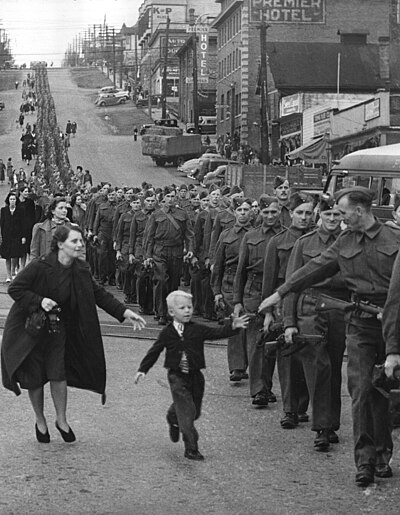User:Allard
Hello and a warm welcome to all my fellow Wikipedians. How nice of you to drop in to see who I am!
Morning>
Wikipedia & me:
[edit]How I discovered Wikipedia, I do not remember. But from being a reader I slowly became a contributor. Although I don't work that much on Wikipedia I do see myself as a Wikipedian. I don't go searching on Wikipedia what I can edit next, I edit what I find and want to do. This means I add and mainly improve a lot of small things and only rarely I make large edits.
My work:
[edit]Articles I've started on Wikipedia:
- Fort Knox Bullion Depository
- Animals are Beautiful People
- Template:David Attenborough Television Series
- Template:Malta Islands
Images I made for Wikipedia:
 Dutch lower house as from 2006
Dutch lower house as from 2006 New image of the Netherlands Air Force Roundel
New image of the Netherlands Air Force RoundelMap on membership of the League of Nations
United Nations membership map
 Improved image of the British Helgoland flag
Improved image of the British Helgoland flag New image showing the current flag of Hel(i)goland
New image showing the current flag of Hel(i)goland
Article guide:
[edit]A list of articles worth looking at, if one can find them:
- Antidisestablishmentarianism
- Ball's Pyramid
- British Isles (terminology)
- Eadweard Muybridge
- Gunpowder Plot
- Horace de Vere Cole
- Humphrey (cat)
- Islomania
- List of countries by date of nationhood
- List of flags
- List of people who died on their birthdays
- List of regnal numerals of future British monarchs
- List of unusual deaths
- Northwest Angle
- Quadripoint
- Racetrack Playa
- Rule of tincture
- San Gimignano
- Transcontinental country
- Undivided India & Partition of India
- Voyager Golden Record
- Web colors
- Winchester Mystery House
And there's always the Random article
And to all citizens of the European Union, please read this: Oneseat.eu
News
[edit]- The International Criminal Court issues arrest warrants for Israeli prime minister Benjamin Netanyahu (pictured), former Israeli defense minister Yoav Gallant, and Hamas leader Mohammed Deif in its investigation of war crimes in Palestine.
- Forty-five pro-democracy activists are sentenced under the Hong Kong national security law for their participation in the 2020 pro-democracy primaries.
- In Canadian football, the Toronto Argonauts defeat the Winnipeg Blue Bombers to win the Grey Cup.
Selected anniversaries
[edit]- 1574 – Juan Fernández, a Spanish explorer, discovered an archipelago that now bears his name off the coast of Chile.
- 1635 – Dutch colonial forces on Formosa launched a three-month pacification campaign against Taiwanese indigenous peoples.
- 1963 – John F. Kennedy was assassinated by Lee Harvey Oswald in Dallas; hours later, Lyndon B. Johnson was sworn in as the 36th president of the United States (pictured).
- 1971 – In Britain's worst mountaineering tragedy, five teenage students and one of their leaders were found dead from exposure on the Cairngorm Plateau in the Scottish Highlands.
- Frank Matcham (b. 1854)
- Edwin Thumboo (b. 1933)
- Chip Berlet (b. 1949)
- Scarlett Johansson (b. 1984)
Did you know...
[edit]- ... that the murder of Wang Lianying was followed by a blitz of newspaper coverage, books, stage performances, a film, and songs (example featured)?
- ... that Michael F. Adams was the first president of Centre College not to be a Presbyterian?
- ... that between 30 and 300 million rupees' worth of goods were plundered during the Afghan sack of Delhi?
- ... that Shuah Khan, the first woman fellow of the Linux Foundation, "signed off" on a patch recommending the use of inclusive terminology in the Linux kernel?
- ... that Benjamin Britten was said to have composed Canticle V: The Death of Saint Narcissus "in the face of death"?
- ... that Last Call BBS contains a chip-manufacturing game, a model-building simulator, a game of solitaire, and more?
- ... that Pablo Barragán originally wanted to be a jazz saxophonist, but was more attracted to the clarinet because he thought it resembled the human voice?
- ... that Malfunction Junction in Birmingham, Alabama, carried 160,000 vehicles in 2018, instead of 80,000 as it was intended to hold?
- ... that according to the author of Stuff Matters, holding a sample of an aerogel is "like holding a piece of sky"?
Today's featured article
[edit]
In historical linguistics, Weise's law describes the loss of palatal quality some consonants undergo in specific contexts in the Proto-Indo-European language. In short, when the consonants represented by *ḱ *ǵ *ǵʰ, called palatovelar consonants, are followed by *r, they lose their palatal quality, leading to a loss in distinction between them and the plain velar consonants *k *g *gʰ. Some exceptions exist, such as when the *r is followed by *i or when the palatal form is restored by analogy with related words. Although this sound change is most prominent in the satem languages, it is believed that the change must have occurred prior to the centum–satem division, based on an earlier sound change which affected the distribution of Proto-Indo-European *u and *r. The law is named after the German linguist Oskar Weise (epitaph pictured), who first postulated it in 1881 as the solution to reconciling cognates in Ancient Greek and Sanskrit. (Full article...)









